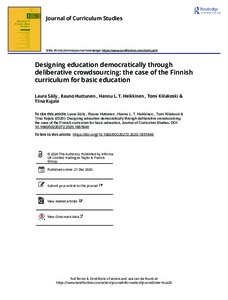Designing education democratically through deliberative crowdsourcing: the case of the Finnish curriculum for basic education
Laura Säily; Rauno Huttunen; Hannu L. T. Heikkinen; Tomi Kiilakoski; Tiina Kujala
https://urn.fi/URN:NBN:fi-fe2021042826486
Tiivistelmä
In Finland, curriculum design is allegedly carried out through a
deliberative process that involves various stakeholders, interest
groups, experts and ordinary citizens. To facilitate participation in
curriculum design, online crowdsourcing has been applied. The objective
of this study is to explore to what extent the design process of the
latest Finnish national curriculum for mathematics was open, democratic
and deliberative. The theoretical framework of the study is the theory
of democratic will-formation of the German philosopher Jürgen Habermas.
The comments given on the early version of the core curriculum of
mathematics were analysed using directed content analysis, in which the
above theory was applied. In the empirical analysis, the comments on the
core curriculum were divided into three categories based on the
quantity and quality of the arguments: strong, medium and weak
modifications. Based on this empirical analysis, it is argued that
majority of modifications suggested by commenters did not play a
significant role in the curriculum design. Thus, in terms of the theory
of democratic will-formation, there are legitimate reasons to suspect
that the process was not as democratic as it was intended to be. To
conclude, limits and opportunities for deliberative democracy in
curriculum design are reflected upon.
Kokoelmat
- Rinnakkaistallenteet [27094]
